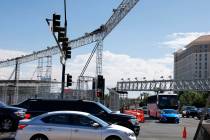Las Vegas Valley needs better roads. Who will pay for them?
As the Las Vegas Valley continues to grow, keeping pace with needed road and infrastructure improvements will prove vital to area transportation, but recent funding issues could affect future projects in Southern Nevada.
This year major projects such as the Interstate 15-Tropicana interchange project are winding down, and the Maryland Parkway bus rapid transit project is moving along. Other infrastructure projects for the area are going to be tougher to plan as inflation has a significant impact on funding for projects in Las Vegas and Nevada.
As Nevada Department of Transportation director Tracy Larkin Thomason said, “Funding is their favorite ‘F’ word,” but that word has been tougher to come by in recent years.
“It’s a struggle at this time, we’re not going to lie about it,” Larkin Thomason said last week during a transportation panel breakfast for commercial real estate development association NAIOP Southern Nevada. “We’re looking at the highway state fuel tax and the federal fuel tax was established in 1993. … So, we’re building a 2025 transportation system on a 1993 budget.”
Budget
NDOT’s working budget for 2025-26 is estimated to be $896 million, with $608 million derived from federal dollars.
“We now have a federal program that is 61 percent of our program and with the recent change in administration, it’s been a lot of uncertainty,” Larkin Thomason said. “It’s calming down, things are moving forward.”
The 2025-26 budget is 25 percent lower than NDOT’s budget in 2023-24, which was $1.2 billion.
Since 2021 construction inflation has increased by 68 percent nationally and between 50 and 60 percent in the Silver State, Larkin Thomason said.
“Which just means there’s less projects going out,” she said. “When we look at our state dollars, we have to make sure that our employees are paid, we have to make sure that our lights are on. We’re doing our sanding, we’re doing our plowing. We’re doing the safety things that we need to do.”
Deferred projects
Because of rising construction costs, NDOT had to cancel nearly all projects solely funded by state dollars, Larkin Thomason said.
“But we still are on track for a number of the big ones as we’re talking about the grants,” she said. “We do have a number of grants throughout the state and we don’t want to miss out on taking advantage of those federal dollars.”
NDOT spokeswoman Kelsey McFarland later clarified that the projects Larkin Thomason spoke of aren’t canceled in full; they are just being deferred to another budget cycle. The only project fully canceled was the planned Downtown Access Project, which could’ve overhauled a key stretch of Interstate 11, also known as U.S. Highway 95, through downtown. The project, which could’ve cost north of $5 billion, was ultimately canceled because of environmental issues and cost concerns.
Despite the funding issues Larkin Thomason is confident that the department will make it through the rocky time.
“We always survive,” Larkin Thomason said. “I’ve been through a number of recessions. We’re resilient. Nevada is a resilient state, but we’re going to go through one of those cycles right now.”
Fuel revenue indexing
Regional Transportation Deputy CEO David Swallow said inflation is a key concern for the Southern Nevada transit agency, but especially in recent years.
“We’ve seen steep inflation in the last couple of years, especially coming out of the pandemic.”
Swallow highlighted the importance of the fuel revenue index program enacted in 2013, which is tied to inflation.
“With that, it’s helped us keep pace with inflation,” Swallow said. “Yeah, we’ve had some challenges in the last couple of years. It’s great that we came out of the pandemic, but I think that surge in demand also created some challenges in getting materials that the supply chain was tight and with that the prices go up. It’s economics 101.”
Last year the index rose by 2.9 cents to 23 cents per gallon of gas sold going toward the program that raises funding for road projects. The inflation rate is based on a 10-year rolling average of the producer index, but it cannot exceed 4 cents per gallon per year, according to the RTC.
Fuel revenue indexing is one of the three key sources of highway funding in Clark County. Motor vehicle fuel tax and sales tax are the other two major sources.
The revenue index funding was approved by Clark County voters in 2014 after the 2013 legislative approval, for an initial three-year term. In 2016, Clark County voters approved a 10-year extension of the program through 2026.
With the valley continuing to grow and the improvements that have already been made eventually needing repair, Swallow said the FRI is a crucial funding mechanism for Clark County.
“Going forward we’re still going to see increasing demands for development and expanding our roadway network. Not just expanding it but maintaining it. We’ve literally spent billions of dollars on our road network, and it’s a really good road network, but we’ve got to maintain it too. So, it’s really important to us to have that funding in place to keep all the infrastructure in a state of good repair.”
Future of FRI
Swallow is confident that the fuel revenue indexing program will again be extended next year, either by a vote or legislative action.
“Right now, there are some talks about legislatively possibly doing a short-term extension for the program to keep it going to ensure that we continue to have that robust funding source in place,” Swallow said.
The RTC’s Fiscal Year 2025 budget is $1.1 billion, with sales tax being the largest funding source at $327 million (29 percent), according to the RTC website.
Contact Mick Akers at makers@reviewjournal.com or 702-387-2920. Follow @mickakers on X.























